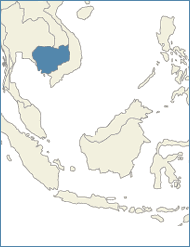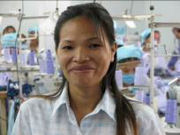 |
|
 |
 |
 |
| USAID Information:
External Links:
|
|
 |
 |
|
 |
 |
|
Cambodia

SNAPSHOT
Date of independence: 1953
Capital: Phnom Penh
Population: 14.2 million (2006)
Annual income per person: $490 (2006)
Source: World Bank Development Indicators 2007
USAID IN CAMBODIA
www.usaid.gov/kh/
CONTACTS
Mission Director
Erin Soto
USAID/Phnom Penh
U.S. Embassy Phnom Penh
Tel: 855-23-728 300
Desk Officer
Deidra Winston
Tel: (202) 712-5275
Email:DWinston@usaid.gov 
Approximately 350,000 workers are employed in more than 300 garment factories in Cambodia. Nearly 90 percent of them are young women. Through a USAID-funded training project, supervisors like Khuoch Davy are improving their productivity and income. The Garment Industry Productivity Center aims to improve the competitiveness of Cambodia’s predominant export industry and facilitate the advancement of a larger number of Cambodians into management positions. (Photo: USAID / GIPC) Overview
Although Cambodia has experienced steady growth since 1999, the economy is fragile and undiversified. The government is hampered by weak institutions, lack of transparency, and an entrenched system of patronage. Although recent and upcoming elections hold promise for a more open political environment, power remains concentrated in the executive branch, and opposition parties are disorganized and divided. Each year, 250,000 youth enter the workforce but cannot find employment. The health care and education systems are underfunded. Infectious diseases such as HIV/AIDS, tuberculosis (TB), avian influenza, and dengue fever are serious concerns. USAID’s objectives in Cambodia are to combat corruption; strengthen key political rights and civil liberties; improve private sector competitiveness and the business enabling environment to attract investment and create jobs; strengthen national health systems and improve the health of Cambodians; and improve basic education.
Programs
Governing Justly and Democratically
USAID engages with human rights organizations and reformers to combat corruption, strengthen key political and civil liberties, improve human rights, and lay the groundwork for reform. By informing and fueling public debate, USAID is building the political will for change. The number of civil society organizations raising awareness about the impact of corruption and advocating passage of an anti-corruption law that meets international standards has increased from one in 2004 to more than 40 in 2007. Over 900,000 citizens have signed a petition calling for such a law. USAID efforts to educate local governments on the political norms of partnership, participation, transparency, and accountability reached 230 communities in 2007 and will expand to 350 communities in 2008. Meanwhile, USAID-funded programs in 2007 trained 325 judges to improve independence, accountability, public awareness, and advocacy.
Investing In People
USAID is working to combat a variety of health problems in Cambodia. The country’s maternal mortality rate is the highest in Southeast Asia, and the number of newborn deaths is also extremely high. USAID is improving maternal and child health by developing national policies and strengthening national systems, improving clinical skills, expanding community outreach, providing community education, and improving access to quality services. Although the HIV prevalence rate is high in specific populations, USAID programs have helped reduce overall HIV prevalence in Cambodia from 2 percent in 1998 to less than 1 percent in 2007. TB, which affects 64 percent of the population, is also a major problem. USAID’s support of the national TB-control program and the expansion of community-based services has helped maintain detection rates of new TB cases at approximately 70 percent. These programs boast a 90 percent treatment success rate. USAID’s avian influenza program has raised public awareness about this growing problem and strengthened the national response to suspected outbreaks. USAID also is working to combat the growing problems of drug-resistant malaria and dengue fever.
The school drop-out rate is high, so USAID is focused on improving education quality and increasing access for marginalized populations. About 60 percent of Cambodian children attend secondary school. The adult literacy rate is 73.6 percent. USAID is improving education quality by training teachers in the four poorest provinces on how to use the newly approved national curriculum and learning standards, assisting school directors to measure school performance, strengthening the leadership of the educational system, and utilizing student interventions such as scholarships.
Economic Growth
USAID's economic programs have improved the investment environment and enhanced competitiveness. This includes strengthening the productivity of small- and medium-sized enterprises that employ most of the population, as well as large-scale enterprises like garment factories. Complementary efforts include workforce development, labor dispute resolution, and the generation of private sector demand for policy, legal, and regulatory reforms. Since 2006, over 1,200 entrepreneurs have received training and technical assistance, resulting in average sales increases of 100 percent to 300 percent. Over 800 of these entrepreneurs have formed business interest groups that are now achieving national policy and regulatory reforms. Over 150 garment industry workers and managers have been trained to enhance productivity and develop industry-wide workforce improvements. In addition, USAID has improved industrial labor relations by training more than 70 conciliators, negotiating 40 collective bargaining agreements and successfully arbitrating over 200 labor dispute cases.
Back to Top ^
|


